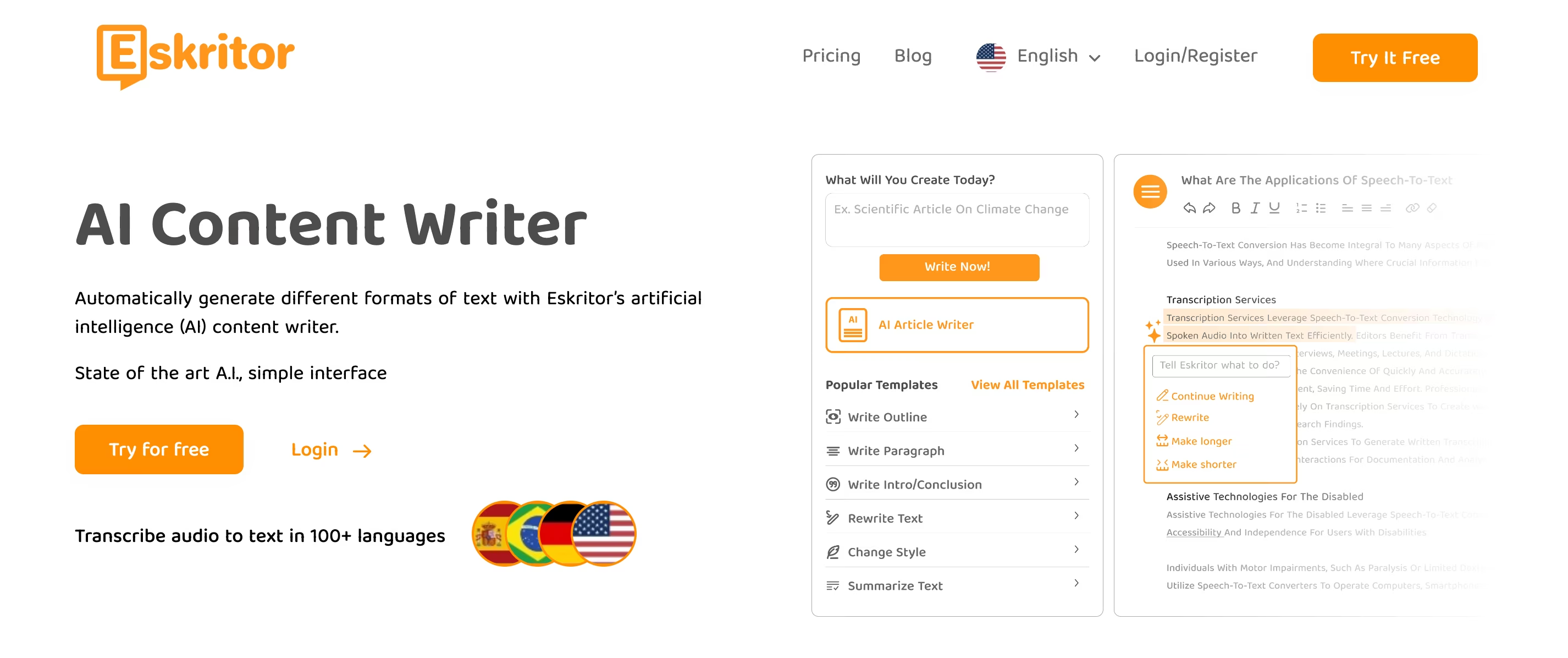This guide will explore how to perform a content gap analysis to improve your SEO strategy. We’ll discuss traditional methods and highlight how AI-powered content gap analysis tools can streamline the process, helping you efficiently identify and fill content gaps.
We’ll also explain how to use AI tools such as Eskritor for automated content gap analysis and discuss common mistakes to avoid.
What is a Content Gap Analysis?
A content gap analysis is the process of identifying and filling gaps in content topics. Filling these gaps yields better results as it covers the topic more comprehensively. A content gap analysis evaluates keywords, formats, quality, and messaging around a specific topic.
This analysis also helps you compare your content with competitors’ content, identifying areas for improvement. Overall, a content gap analysis enhances your content strategy by revealing areas to meet your target audience’s needs and improve SEO visibility.

Why Is Content Gap Analysis Important for SEO?
Content gap analysis helps identify missing topics and keywords essential to your SEO strategy. By identifying and filling these gaps, you can improve your SEO performance.
How Identifying Gaps Improves Keyword Targeting
By identifying gaps in your content, you can target relevant, high-traffic keywords that align with user intent. This makes your content more discoverable and boosts organic reach. Targeting untapped keywords reduces competition and improves ranking potential, ultimately benefiting SEO.
The Impact of Content Gaps on Search Rankings and Traffic
Search engines favor websites that comprehensively answer user queries, so that content needs to be added to ensure visibility. When content gaps are not identified and filled, they negatively affect search rankings and traffic. Filling these gaps improves site authority, search engine rankings, and targeted traffic, ultimately supporting your SEO strategy.

How to Perform a Content Gap Analysis Step-by-Step
While performing a content gap analysis, you need to pay attention to several crucial points. Here is a step-by-step guide to conducting one.
Research Competitor Content
Identify topics and content types and examine their content. Look at their keywords, their topics, and their types of content such as blogs, guides, or videos. You can use tools to analyze your competitors’ high-ranking pages or keywords. This analysis will show you the gaps in your content and the topics they are missing so that you can cover them.
Analyze Your Existing Content Inventory
Next, review your current content to understand what’s already published and where there might be gaps. Create a content inventory and list each piece of content along with relevant metrics such as page views, engagement rates, and keywords. This helps identify which parts are underperforming or missing crucial keywords and topics. Mapping out your existing content also makes it easier to spot opportunities for updates, expansions, or new content.
Use Keyword Research to Find Gaps
Keyword research is essential to finding content gaps. Use SEO tools to discover keywords relevant to your field but not yet covered in your content. Look for keywords your competitors rank for, but you don’t. This research helps identify missing topics, enables you to fill these gaps, and boosts your SEO strategy effectively.

How AI-Powered Content Gap Analysis Tools Can Help
Manual content gap analysis can be an overwhelming and time-consuming process as you will have to read every content related to your field and check your previous content. Thus, AI-powered content gap analysis tools can help you by automating and easing this process.
Benefits of Using AI for Gap Identification
AI-powered content gap analysis can efficiently identify content gaps by looking at massive amounts of data in minutes. These tools assess competitor content, current trends, and user search intent to reveal missing topics or keywords you have overlooked. By automating the process, AI saves time and provides insights into less apparent gaps. AI tools help you create highly relevant, targeted content that enhances SEO and user engagement.
Top AI Tools for Automated Content Gap Analysis
Several AI tools are available for automated content gap analysis. We have listed the top AI tools for you.
- Eskritor: You can upload texts to get summaries and outlines of the content. By looking at the summary and outline, you can easily spot the content gaps without reading all the content.
- MarketMuse: MarketMuse is known for its deep content analysis. It identifies topic gaps and missing keywords. The tool also offers data-driven recommendations to improve content relevance and SEO.
- Clearscope: Cleascope focuses on keyword optimization and gap analysis. The tool evaluates top-ranking content to provide a roadmap.
- Surfer SEO: Surfer SEO’s AI allows you to examine your content, highlight gaps, and suggest improvements.

How to Use AI Writing Tools to Fill Content Gaps
After detecting content gaps, you can use AI writing tools to fill the gaps in your content efficiently. These tools provide many features to generate unique and personalized text within seconds. So, once you identify the gaps, you can tell the tool to create texts that will fill the gaps.
Writing Assistants for Content Strategy Improvements
Writing assistants for content strategy, such as Eskritor, are efficient and fast for strategy improvements. These tools can generate unique and personalized text, which improves audience engagement and optimizes content strategies.
For instance, Eskritor is an AI-powered tool that generates different formats of text within seconds. With Eskritor, you can extract keywords from text , write an email for a job application , develop scripts, and even generate interview questions for teachers .
These and similar features improve your content strategy critically and eliminate the time consumed by the manual content creation process.
How AI-Generated Text Can Speed Up Content Creation
AI-generated text for content gaps speeds up content creation by automating the process. AI tools refine your content with targeted enhancements and maintain your unique writing style.
AI writing tools allow you to decide your content's length, tone, and language. Then, you can briefly review and edit your content instead of writing it from scratch.
Common Mistakes to Avoid in Content Gap Analysis
The most common mistakes to avoid in content gap analysis are overlooking competitor long-tail keywords and focusing solely on high-volume keywords. Here is how to avoid these mistakes.
Overlooking Competitor Long-Tail Keywords
Long-tail keywords are longer search phrases, typically three or more words. They have particular search intent. Because they are more unique, they have lower search volumes. Also, they have higher conversion rates because they are more targeted.
A common mistake is neglecting competitor long-tail keywords because they are precise. Although they have lower search volumes, they can improve your rankings for niche topics and capture a more targeted audience. Avoid overlooking these keywords and try to uncover hidden opportunities for improving your content.
Focusing Solely on High-Volume Keywords
High-volume keywords are search terms with a high search volume. This means that many people are searching for these terms on browsers such as Google, Yahoo, and Bing.
Despite having large search volumes, solely focusing on these keywords is not good. High-volume keywords typically have intense competition. This competition makes it harder to rank well by using only these keywords.
Try to focus on these and pay attention to lower-volume keywords. You must balance high-volume and lower-volume keywords to reach different user intents and a broader range of topics.
How to Implement Findings from a Content Gap Analysis for SEO Success
Conducting a content gap analysis and trying to fulfill every gap can be overwhelming if it is not planned properly. Remember that you need a detailed plan for SEO success through content gap analysis.
To implement findings from a content gap analysis for SEO success, you must prioritize gaps based on opportunity and traffic potential and create a content calendar to address gaps efficiently. Here is a more detailed look at how to actualize these.

Prioritizing Gaps Based on Opportunity and Traffic Potential
It is essential to prioritize content gaps once you have identified them. You can do this according to their potential impact. Evaluate each gap by factors such as search volume, keyword intensity, and relevance with your audience’s tendencies.
Focus on opportunities that balance manageable competition with substantial traffic potential, as these will likely yield quick and sustainable results. Prioritizing strategically ensures that your efforts maximize visibility and return on investment in your SEO strategy.
Creating a Content Calendar to Address Gaps Efficiently
A content calendar helps organize and streamline the process of filling content gaps. Based on your priorities, schedule new content, updates, or expansions to existing pieces. Aim for a consistent publishing cadence.
This approach enables you to address gaps systematically, stay on track, and measure progress over time. A well-planned calendar also helps align content efforts with other marketing activities. Thus, you ensure your site stays fresh and relevant for search engines and users.





 Dubai, UAE
Dubai, UAE